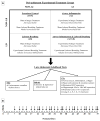Peri-adolescent asthma symptoms cause adult anxiety-related behavior and neurobiological processes in mice
- PMID: 28284954
- PMCID: PMC5497519
- DOI: 10.1016/j.bbr.2017.02.046
Peri-adolescent asthma symptoms cause adult anxiety-related behavior and neurobiological processes in mice
Abstract
Human and animal studies have shown that physical challenges and stressors during adolescence can have significant influences on behavioral and neurobiological development associated with internalizing disorders such as anxiety and depression. Given the prevalence of asthma during adolescence and increased rates of internalizing disorders in humans with asthma, we used a mouse model to test if and which symptoms of adolescent allergic asthma (airway inflammation or labored breathing) cause adult anxiety- and depression-related behavior and brain function. To mimic symptoms of allergic asthma in young BALB/cJ mice (postnatal days [P] 7-57; N=98), we induced lung inflammation with repeated intranasal administration of house dust mite extract (most common aeroallergen for humans) and bronchoconstriction with aerosolized methacholine (non-selective muscarinic receptor agonist). Three experimental groups, in addition to a control group, included: (1) "Airway inflammation only", allergen exposure 3 times/week, (2) "Labored breathing only", methacholine exposure once/week, and (3) "Airway inflammation+Labored breathing", allergen and methacholine exposure. Compared to controls, mice that experienced methacholine-induced labored breathing during adolescence displayed a ∼20% decrease in time on open arms of the elevated plus maze in early adulthood (P60), a ∼30% decrease in brainstem serotonin transporter (SERT) mRNA expression and a ∼50% increase in hippocampal serotonin receptor 1a (5Htr1a) and corticotropin releasing hormone receptor 1 (Crhr1) expression in adulthood (P75). This is the first evidence that experimentally-induced clinical symptoms of adolescent asthma alter adult anxiety-related behavior and brain function several weeks after completion of asthma manipulations.
Keywords: Adolescence; Anxiety; Asthma; House dust mite; Methacholine; Sex differences.
Copyright © 2017 Elsevier B.V. All rights reserved.
Figures






Similar articles
-
Asthma Induction During Development and Adult Lung Function, Behavior and Brain Gene Expression.Front Behav Neurosci. 2018 Aug 30;12:188. doi: 10.3389/fnbeh.2018.00188. eCollection 2018. Front Behav Neurosci. 2018. PMID: 30214402 Free PMC article.
-
Inhaled corticosteroids as treatment for adolescent asthma: effects on adult anxiety-related outcomes in a murine model.Psychopharmacology (Berl). 2021 Jan;238(1):165-179. doi: 10.1007/s00213-020-05666-x. Epub 2020 Oct 4. Psychopharmacology (Berl). 2021. PMID: 33011818 Free PMC article.
-
Mast cell-derived serotonin enhances methacholine-induced airway hyperresponsiveness in house dust mite-induced experimental asthma.Allergy. 2021 Jul;76(7):2057-2069. doi: 10.1111/all.14748. Epub 2021 Mar 9. Allergy. 2021. PMID: 33486786
-
Brain structural and functional alterations related to anxiety in allergic asthma.Brain Res Bull. 2023 Oct 1;202:110727. doi: 10.1016/j.brainresbull.2023.110727. Epub 2023 Aug 9. Brain Res Bull. 2023. PMID: 37562517 Review.
-
Experimental modeling of anxiety and depression.Acta Neurobiol Exp (Wars). 2004;64(4):439-48. doi: 10.55782/ane-2004-1526. Acta Neurobiol Exp (Wars). 2004. PMID: 15586660 Review.
Cited by
-
Asthma and posttraumatic stress disorder (PTSD): Emerging links, potential models and mechanisms.Brain Behav Immun. 2021 Oct;97:275-285. doi: 10.1016/j.bbi.2021.06.001. Epub 2021 Jun 6. Brain Behav Immun. 2021. PMID: 34107349 Free PMC article. Review.
-
Peri-adolescent asthma: Acute impacts on innate immune response, corticosterone, and microglia in mice.J Neuroimmunol. 2021 Jan 15;350:577450. doi: 10.1016/j.jneuroim.2020.577450. Epub 2020 Nov 25. J Neuroimmunol. 2021. PMID: 33285450 Free PMC article.
-
Asthma Induction During Development and Adult Lung Function, Behavior and Brain Gene Expression.Front Behav Neurosci. 2018 Aug 30;12:188. doi: 10.3389/fnbeh.2018.00188. eCollection 2018. Front Behav Neurosci. 2018. PMID: 30214402 Free PMC article.
-
Inhaled corticosteroids as treatment for adolescent asthma: effects on adult anxiety-related outcomes in a murine model.Psychopharmacology (Berl). 2021 Jan;238(1):165-179. doi: 10.1007/s00213-020-05666-x. Epub 2020 Oct 4. Psychopharmacology (Berl). 2021. PMID: 33011818 Free PMC article.
-
Modulation of fear behavior and neuroimmune alterations in house dust mite exposed A/J mice, a model of severe asthma.Brain Behav Immun. 2020 Aug;88:688-698. doi: 10.1016/j.bbi.2020.04.084. Epub 2020 May 4. Brain Behav Immun. 2020. PMID: 32380274 Free PMC article.
References
-
- Spear LP. The adolescent brain and age-related behavioral manifestations. Neurosci Biobehav Rev. 2000;24:417–463. http://dx.doi.org/10.1016/S0149-7634(00)00014-2. - DOI - PubMed
Publication types
MeSH terms
Substances
Grants and funding
LinkOut - more resources
Full Text Sources
Other Literature Sources
Medical
Research Materials

